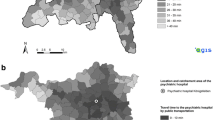Summary
In this paper, ecological patterning has been looked at for the various major psychiatric diagnostic groupings. Due to many changes in social composition, land use and other geographic changes, patterning is not as clearcut as it was whenFaris andDunham did their study. Communities are no longer as homogeneous or stable as they were in the twenties and thirties. Intercity expressways and industrial development have changed the geography of many community areas. We have presented a number of maps showing ecological patterning by place of residence of unduplicated admissions to fortyfour public and private mental institutions by City of Chicago people from July 1, 1960 to June 30, 1961. In general, the patterning is not clearcut. However, patterning for the unduplicated schizophrenic admissions was quite pronounced and in agreement with the patterning reported byFaris andDunham. When we looked at first admission schizophrenics, no definite pattern could be found which implies that first admissions come from all over the city. Further analysis is needed into the patterns of hospital utilization of first admissions in comparison to readmissions.
Résumé
Dans ce travail, on a examiné les distributions écologiques pour les différents groupes diagnostiques psychiatriques principaux. A cause de bien des changements dans la composition sociale et dans la répartition géographique, les distributions ne sont pas aussi nettement déterminées qu'au moment oùFaris etDunham ont fait leur étude. Les communautés ne sont plus aussi homogènes ou stables qu'elles l'étaient dans les années 20 et 30. Les communications rapides entre les villes et le développement industriel ont changé la géographie de bien des communes. Nous avons présenté un certain nombre de cartes montrant la distribution écologique selon le lieu de résidence des admissions non répétées dans 44 institutions psychiatriques publiques et privées de la ville de Chicago, du 1er juillet 1960 au 30 juin 1961. En général, la distribution n'est pas clairement déterminée. Cependant, la distribution des admissions non répétées de schizophrènes était assez prononcée et en accord avec le schéma deFaris etDunham. Quand nous avons examiné les premières admissions de schizophrènes, nous n'avons pas pu trouver un schéma défini qui implique que les premières admissions proviennent de toute la ville. Il est nécessaire de pousser plus avant l'analyse des «patterns» d'utilisation de l'hôpital des premières admissions par rapport aux réadmissions.
Zusammenfassung
In diesem Artikel wurde das ökologische Verteilungsbild auf die verschiedenen Hauptgruppen psychiatrischer Diagnostik hin betrachtet. Aufgrund von vielen Verände-rungen in der sozialen Zusammensetzung, in der Bodennutzung und anderen geographischen Veränderungen, ist die Verteilung nicht so eindeutig wie zu der Zeit der Untersuchung vonFaris undDunham. Die Gemeinden sind nicht mehr so homogen oder stabil wie in den zwanziger und dreißiger Jahren. Verkehrslinien innerhalb der Stadt und industrielle Entwicklung haben die Geographie vieler Gemeindegebiete verändert. Wir haben eine Anzahl von Karten herausgebracht, die das ökologische Verteilungsbild aufgrund der Wohngegend von ein-maligen Aufnahmefällen aus der Bevölkerung der Innenstadt von Chikago in 44 öffentliche und private psychiatrische Institutionen vom 1. Juli 1960 bis 30. Juni 1961 zeigen. Im allgemeinen ist das Verteilungsbild nicht eindeutig. Jedoch war das Verteilungsbild für die einmaligen Aufnahmen von Schizo-phrenen klar umrissen und in Übereinstimmung mit der Verteilung, wie sie vonFaris undDunham berichtet wurde. Bei der Betrachtung der Erstaufnahmen von Schizophrenen konnten wir keine endgültige Verteilung finden, was bedeutet, daß die Erstaufnahmen aus der ganzen Stadt kamen. Es bedarf einer weiteren Analyse der Verteilungsbilder von der Nutzung von Krankenhäusern durch Erstaufnahmen im Vergleich mit Wiederaufnahmen.
Similar content being viewed by others
References
Faris, R. E. L., andH. W. Dünham: Mental disorders in urban areas. New York: Hafner Publishing Co. 1960.
Holungshead, A. B., andF. C. Redlich: Social class and mental illness. New York: Wiley 1958.
Kitagawa, E. M., andK. E. Taeuber: Local community fact book. Chicago Metropolitan Area 1960. Chicago: University of Chicago Community Inventory 1963.
Park, R. E.: Sociology, community and society. In: Human communities. Glencoe, Ill.: The Free Press 1952.
Rowitz, L., andL. Levy: Ecological analysis of treated mental disorders in Chicago. Arch. gen. Psychiat.19, 571–579 (1968).
Stein, M. R.: The eclipse of community. New York: Harper and Row, Harper Torchbooks 1964.
Author information
Authors and Affiliations
Rights and permissions
About this article
Cite this article
Levy, L., Rowitz, L. The spatial distribution of treated mental disorders in Chicago. Soc Psychiatry 5, 1–11 (1970). https://doi.org/10.1007/BF01539790
Issue Date:
DOI: https://doi.org/10.1007/BF01539790




